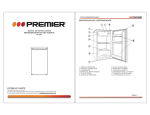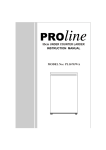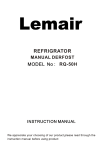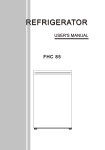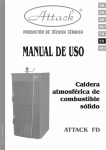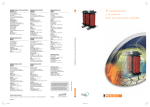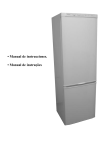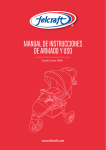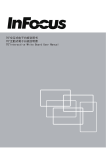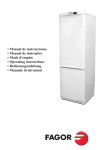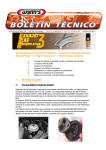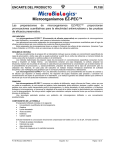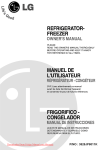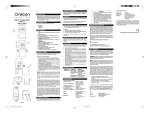Download Manual en Español-English
Transcript
MANUAL DE INSTRUCCIONES REFRIGERADOR DE UNA PUERTA NV-1897 / NV-1900 ESTIMADO CLIENTE Felicitaciones por su compra! Por favor lea cuidadosamente este manual, y guárdelo para su futura referencia. Si necesita soporte adicional, no dude en escribir a: [email protected] DESCRIPCIÓN DEL REFRIGERADOR 1. CUBIERTA SUPERIOR 2. TAPA DEL CONGELADOR 3. CONGELADOR 4. REPISA DEL REFRIJERADOR 5. TAPA DE VIDRIO 6. GAVETA DE VERDURAS 7. PATAS NIVELADORAS 8. RPISAS DE LA PUERTA 9. JUNTA DE LA PUERTA 10. INTERRUPTOR DE LA PUERTA 11. TERMOSTATO REGULABLE 12. EVAPORADOR (Al interior) Pagina 1 2. UBICACIÓN CORRECTA PARA LA INSTALACIÓN BUENA VENTILACIÓN Este refrigerador necesita tener una buena ventilación alrededor para que el calor se disipe fácilmente, que el refrigerador rinda adecuadamente y que no se consuma excesiva energía eléctrica. Por lo tanto, asegúrese de que haya suficiente espacio libre alrededor del refrigerador. En la parte posterior deje al menos 100m de distancia a la pared, 100mm a los costados y al menos 200mm en la parte superior. Debe haber espacio suficiente para abrir la puerta a 160º. FUENTE DE ENERGÍA Este refrigerador debe ser enchufado solamente a un tomacorriente monofásico corriente alterna con un voltaje de 115V ~ 60Hz. Si la fluctuación de voltaje de área es mayor al rango aceptado por este refrigerador, asegúrese de emplear regulador de voltaje AC automático. Este refrigerador debe ser enchufado a tomacorriente especial. El tomacorriente debe contar con una conexión a tierra. CABLE DE ENERGÍA El cable de energía debe estar estirado o doblado dentro de la bobina durante el funcionamiento. Así también queda prohibido que el cable de energía quede cerca del compresor ubicado en la parte posterior del refrigerador, ya que la temperatura de su superficie del mismo asciende considerablemente y podría dañar el aislante del cable o provocar un corto circuito. HUMEDAD Evite instalar el refrigerador en ambientes demasiado húmedos para reducir la posibilidad de que las partes metálicas del mismo se corroan. Queda prohibido salpicar agua al refrigerador, caso contrario podría anular la aislamiento o provocar un corto circuito. Pagina 2 de su un un CALOR Mantenga el refrigerador alejado de fuentes de calor o la luz directa del sol. ESTABILIDAD El refrigerador debe ser colocado sobre un piso estable y plano. No lo asiente sobre superficies débiles como ser espuma plástica, etc. Si el refrigerador no está bien nivelado, ajuste las patas de nivel. No coloque el refrigerador cerca de objetos que provoquen vibraciones. SUSTANCIAS PELIGROSAS No coloque el refrigerador cerca de sustancias volátiles o inflamables como ser gas, gasolina, alcohol, aceites, etc. Así mismo, no almacene dichas sustancias dentro del refrigerador. TRASLADO Cuando traslade el refrigerador no debe inclinarlo en posición horizontal o a más de 45º o cabeza abajo. Pagina 3 PRECAUCIONES • El agua contenida en los alimentos o que ingresa al refrigerador por las aperturas de ventilación junto con el aire, podría crear una capa de hielo en el interior del aparato la cual reducirá l rendimiento del refrigerador. Deberá descongelar el refrigerador cuando la capa de hielo tenga más de 2mm de espesor. • El congelador debe ser descongelado manualmente. Retire previamente los alimentos, las cubiteras de hielo y la repisa y guárdelos temporalmente en una conservadora. Seguidamente coloque el termostato en la posición “0” (El compresor se detendrá). Deje la puerta abierta hasta que el hielo se haya derretido y depositado en la parte inferior del congelador. Seque el agua con un paño suave. Si necesita descongelar más rápidamente, coloque un recipiente con agua tibia (aproximadamente a 50º C) dentro del congelador. Después de terminar de descongelar, asegúrese de volver a colocar el termostato en su posición original. • No debe intentar calentar directamente el congelador usando agua caliente o una secadora de cabellos, para evitar que se deforme la gaveta interior. • No use objetos duros o filos o palos para quitar el hielo o separar los alimentos que hayan quedado adheridos al mismo, ya que podría dañar la gaveta o la superficie del evaporador. • Si el cable de energía o el refrigerador están dañados, deberá ser reparado o remplazado solamente por personal técnico calificado ya que se necesitan herramientas especiales. CAMBIAR DE LADO LA PUERTA 1. 2. 3. 4. Retire los dos tornillos (1) que aseguran el panel superior (5) al gabinete. Retire el panel frontal (5) jalando hacia arriba y el frente. Retire los tornillos (6) que aseguran la placa de acero (10). Retire la placa de acero (10) y levante la puerta. Asiente la puerta sobre una superficie suave para evitar que se raye. 5. Retire los dos tornillos (8) que sujetan la bisagra inferior (2) y asegúrese de retirarla. 6. Retire la pata frontal (4) y transfiérala al lado derecho. 7. Antes de colocar la bisagra inferior (2), retire la tuerca (9) y vuelque la bisagra (2). Seguidamente instale la bisagra inferior (2) en el lado izquierdo del marco inferior usando los dos tornillos (8). 8. Introduzca la tuerca (9) en la bisagra inferior (2). 9. Retire la bisagra superior (7) del lado derecho de la placa de acero (10) y coloque la bisagra (7) en el costado derecho de la placa de acero (10). 10. Coloque la puerta en su lugar asegurándose de que calce en la bisagra inferior (2). 11. Sosteniendo la puerta en posición cerrada, coloque la bisagra superior (7) dentro de los orificios de la bisagra de la puerta y asegure la placa de acero (10) en el marco superior usando los tornillos (6). Recuerde no ajustar los tornillos hasta que la parte superior de la puerta esté nivelada con el borde superior. 12. Inserte el borde frontal del panel superior (5) dentro de la placa de metal (10) y asegure el panel superior (5) en la parte superior del gabinete usando los dos tornillos (1). Pagina 4 FIGURA 1 FIGURA 2 FIGURA 1: Como se ve el refrigerador antes de cambiar de lado la puerta. FIGURA 2: Como se ve el refrigerador después de cambiar de lado la puerta. 5. MANTENIMIENTO • • • • • • La limpieza y el mantenimiento del refrigerador debe realizarse una vez por mes. Asegúrese de que el cable de energía esté completamente desenchufado antes de realizar el mantenimiento. Use un paño húmedo para limpiar el interior, exterior y los accesorios del refrigerador. Si se encuentran muy sucios, humedezca el trapo con detergente neutro, enjuague bien con agua y seque con un paño seco. Seguidamente es recomendable usar un poco de pulidor de cristal para pulir el refrigerador. No use agua caliente, diluyentes, petróleo, alcohol, kerosén, detergente en polvo, detergentes alcalinos, ácidos, esponjas químicas, etc., ya que podría dañar el acabado y las piezas plásticas. No debe salpicar agua al refrigerador ya que podría oxidarlo o debilitar los aislantes. Recuerde realizar el mantenimiento del aislante de la puerta ya que debe mantenerse limpio. Si las piezas plásticas están en contacto durante mucho tiempo con aceites vegetales o animales, se envejecerán rápidamente y posiblemente lleguen a romperse. Las repisas se ensuciarán con facilidad si no las limpia con regularidad. Así mismo se producirán malos olores por lo que debe acostumbrarse a limpiar estas piezas periódicamente. Pagina 5 PROBLEMAS Y SOLUCIONES 1. • • • SI EL REFRIGERADOR NO FUNCIONA Revise que no haya habido un corte de energía. Revise que el cable de energía esté enchufado al tomacorriente. Revise que no haya saltado un fusible. 2. SI EL REFRIGERADOR ENFRÍA DEMASIADO • Es posible que el termostato esté en una posición muy alta. • Si ha colocado alimentos que contengan mucho líquido justamente debajo de las salidas de aire, estos se congelarán rápidamente, lo cual no representa falla alguna. 3. • • • • • • • SI EL REFRIGERADOR NO ENFRÍA LO SUFICIENTE Los alimentos están demasiado amontonados y están bloqueando las salidas de aire. Es posible que haya colocado algo muy caliente o demasiados alimentos dentro del refrigerador. Es posible que no haya cerrado bien la puerta. Es posible que el aislante de la puerta esté dañado. El refrigerador no tiene buena ventilación. No hay suficiente espacio libre entre el refrigerador y las superficies circundantes. El termostato no está bien regulado. 4. EL AGUA DEL DESCONGELADO CAE DENTRO DEL REFRIGERADOR Y AL PISO • Revise que el tubo de drenaje y la manguera no estén obstruidas. • Asegúrese que el recipiente de deshielo esté en la posición correcta. 5. SE FORMA CONDENSACIÓN EN LAS PAREDES EXTERIORES DEL REFRIGERADOR • Es posible que se forme condensación durante las estaciones húmedas, de la misma manera que se forma condensación en un vaso con agua fría, por lo tanto, esto no representa falla alguna. 6. SE ESCUCHA UN SONIDO PARECIDO A AGUA QUE FLUYE • Ese sonido es causado por el refrigerante que está circulando, por lo que este sonido no representa falla alguna. 7. LAS PAREDES LATERALES SE CALIENTAN • Las paredes laterales del refrigerador se calientan cuando la puerta es abierta con mucha frecuencia, cuando enciende el refrigerador o durante el verano cuando la temperatura exterior es muy alta. En ese caso no toque las paredes del refrigerador. Esto se debe a la disipación del calor interior y no representa falla alguna. ESPECIFICACIONES TÉCNICAS • • Las especificaciones técnicas se encuentran en la etiqueta situada en la parte posterior del refrigerador. Las especificaciones están sujetas a cambios sin previo aviso. Pagina 6 ATENCIÓN: Nos reservamos el derecho de modificar las especificaciones, características y/u operación de esta unidad sin previo aviso, con el fin de continuar las mejoras y desarrollo del mismo. Pagina 7 1.Name of parts PARTS AND FEATURES Top cover Freezer room cover Pagina 8 Leveling Legs Door balconies Freezer compartment Door gasket Shelves of refrigerator chamber Door switch Glass cover Adjustable thermostat Crisper box Evaporator(inside) 2.Correctly positioning Well Ventilating There is need of good ventilation around the refrigerator for easy dissipation of heat, high efficiency of refrigeration and low power consumption. For this purpose, sufficient clear space should be need around the refrigerator. Its back is at least 100mm away from the wall, its sides at least have a space of 100mm separately and the height from over its top is not less than 200mm. A clear space should be left to open its doors to 160 Power Supply The refrigerator is only applied with power supply of single phase alternating current of 115V~/60Hz. If fluctuationof voltage in the district user is of so large that the voltage exceeds the above scope, for safety sake, be sure to apply a.c. automatic voltage regulator to the refrigerator. The refrigerator must employ a special power socket instead of common one with other electric appliances.Its 115V~ plug must match the socket with ground wire. 60Hz ¡À Power Line Cord The cord should be neither lengthened nor folded into coil during operation. Moreover, it is forbidden that cord is kept close onto the compressor at the back of the refrigerator, the surface temperature of which is quite high when operating. Touching with it would deactivate the insulation or cause leakage for electricity. N Protection from Moisture Avoiding placing the refrigerator in a place where heavy moisture is present so as to minimize possibility of rusty for its metal parts. Still more, the refrigerator is forbidden to be directly sprayed by water, otherwise, poor insulation and current leakage would occur. Pagina 9 Pagina 10 2.Correctly Positioning Protection from Heat The refrigerator should be far away from any heat source or direct sunshine. Fixing Stable Floor on which refrigerator will be placed must be flat and solid. It should not be laid on any soft material such as foam plastic, etc. If the refrigerator is not on the same level, adjust the screws suitably. The refrigerator should not be placed near anything which may echo. Keep Away from Danger It is inadvisable that the refrigerator is placed near any volatilizable or combustible such as gas, petrol, alcohol, lacquer and banana oil, etc. The above-mentioned objects can not be stored in the refrigerator. Moving When fixed or moved, the refrigerator can not be set horizontally or declined to more than 45 or upside-down. Pagina 10 3.Cautions Water contained in food or getting into air inside the refrigerator by opening doors may form a layer of frost inside, It will weaken the refrigerator when the frost is thick, while it is more than 2mm thick, you should defrost. Defrosting in freezer chamber is operated manually. Before defrosting, take the food, the ice tray and the shelf out into the cold storing chamber temporarily then set the knob of the temperature regulator to position"0"(where the compressor will stop working) and leave the door open until ice and frost dissolve thoroughly deposited at the bottom of the freezer chamber, wipe off the water with soft cloth.,In the case of speeding up the defrosting, you may put a bowl of warm water (about 50 C )into the freezer chamber, and It's inadvisable to heat the freezer chamber directly with hot water or hair dryer while defrosting to prevent deformation of the inner case. It's also inadvisable to scrape of ice and frost or separate food from the containers which have been congealed together with the food with sharp tool or wooden bars, so as not to damage the inner casing or the surface of the evaporator. If the supply cord of this appliance is damaged, it must only be replaced by a repair shop appointed by the manufacturer, because special purpose tools are required. Pagina 11 4.Changing the reversible door 1) Remove the two screws (1) joining the top panel (5) to the cabinet. 2) Take away the top panel (5) by pulling it towards the front. 3) Remove the screws (6) which fix the steel plate (10). 4 )Take away the steel plate (10) and lift the door. Put the door on a soft surface to keep it from getting scratched. 5) Remove the two screws (8) that hold the lower hinge (2) and make sure to remove the lower hinge (2). 6) Take off the front left leg (4) and transfer it to the right side. 7) Before placing this lower hinge (2), remove the bolt-pin (9) and reverse the direction of the lower hinge (2). Then install the lower hinge (2) onto the left side of the lower frame with two screws (8). 8) Insert the bolt-pin (9) into the lower hinge (2). 9) Take off the upper hinge (7) on the right hand side of the steel plate (10) and install the upper hinge (7) on the left side of the steel plate (10). 10) Set the door in place making sure the door seats into the lower hinge(2). 11) While holding the door closed, put the upper hinge (7) into the door hinge hole and secure the steel plate(10) in the top frame with the screws(6). Please remember not to tighten the screws (6) until the top of the door is levelled with the counter top. 12) Insert the front edge of the top panel (5) into the steel plate (10) and fix the top panel (5) onto the top of the cabinet with two screws (1). 5 Pagina 12 Pagina 13 5.Maintenance The refrigerator should be cleaned and maintained once a month. When performing maintenance, make absolutely sure that the power plug is first disconnected from the power outlet. Wipe the inner and outer surface of the refrigerator and its accessories with wet cloth. If they are too dirty, scrub them with neutral detergent, and then clean them with water and dry them with clean cloth. After this, a small quantify of glass wax is recommended to polish the refrigerator surface with a flannelette. For cleaning, don't use hot water, diluent, petrol, alcohol, kerosene, washing powder, cleanser, aikailinous detergent, acid, Chemical cloth, etc. So as not to damage the lacquer coat and plastics. It is forbidden than the refrigerator is directly sprayed with water. Otherwise, it would cause rusty or weaken the insulation. Be careful to upkeep the sealing rubber bars of the doors. They should always be cleaned. If the plastic parts in refrigerator remain contaminated for a long time by oil (animal or vegetable), they will be easy aged and possibly cracked. The drain pan gets dirty very easily if it is not cleaned regularly, bad odours will be produced, get into the habit of cleaning this pan regularly. Pagina 14 6. Troubleshooting 1. When the refrigerator does not work Check if there is a power failure. Check if the power plug is plugged into the power outlet. Check that the fuse has not blown. 2. When the refrigerator is cooling excessively The temperature control dial may be set too high. If you place foodstuffs containing a lot of moisture directly under the cool air outlets, they will freeze easily. This does not indicate a malfunction. The food may be packed too tightly together which will block the flow of cool air. 3. When the refrigerator is not cooling sufficiently You may have put something hot or a lot of foodstuffs into the refrigerator . The door may not have been closed properly. The door gaskets may be damaged. The refrigerator may not be ventilated. There may be insufficient clearance between the refrigerator and the surfaces Immediately both sides and above. The temperature control dial may not be set properly. 4. When the defrosting water overflows inside the refrigerator and onto the floor. Check that the drain pipe and the drain hose are not clogged. Check that the drain pan is housed properly. 5. When condensation form on the outside of the refrigerator. Condensation may form on the outside when the humidity is high such as during a wet season. This is the same result as the condensation formed when chilled water is poured into a glass. It does not, therefore, indicate a failure, wipe dry with a dry cloth. 6. When you hear a sound like water flowing . 7. When the cabinet's side panel heats up The side panel of the cabinet will heat up when the door is opened or closed frequently, when starting the unit and when the unit operates in summer with high ambient outside temperature, In such case, do not touch the panel, it results from the dissipation of the heat from inside the cabinet, and it does not mean that something is wrong with the refrigerator. Pagina 15 ATTENTION: The unit may be submitted to changes in specifications, characteristics and/or operation without prior notice to the user, in order to continue improving and developing its technology. Pagina 16 CKPR-A01


















